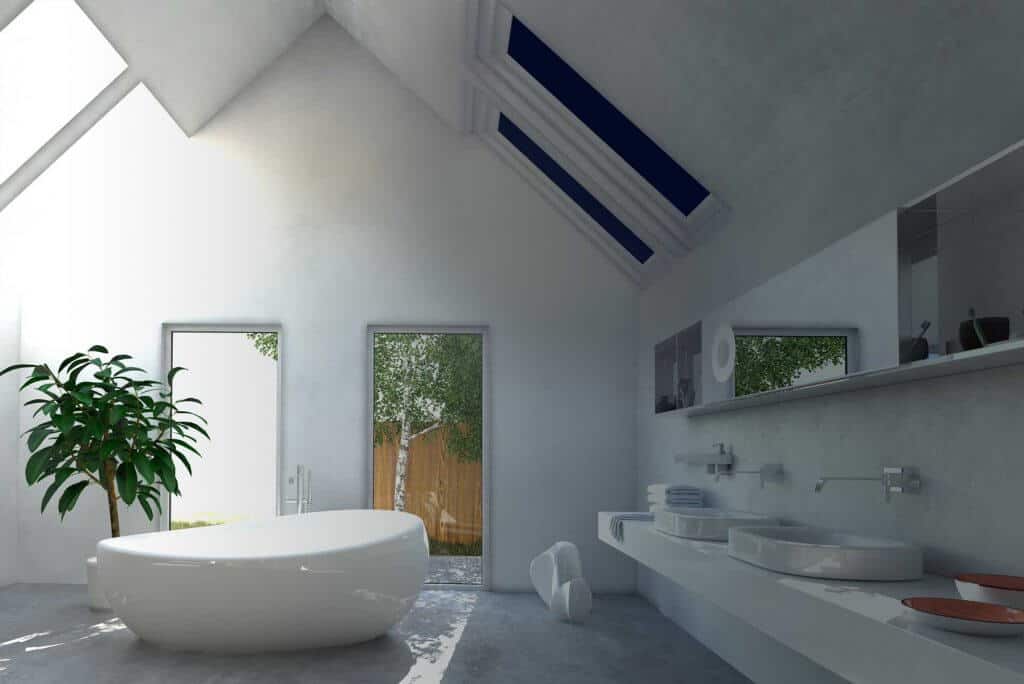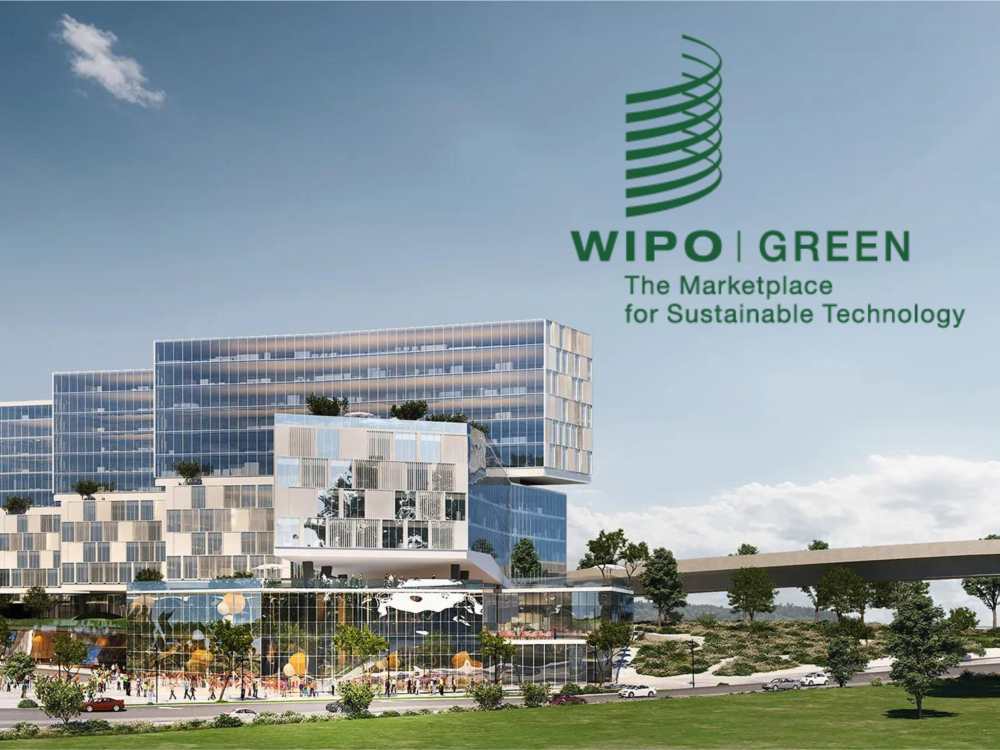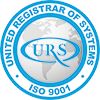SPD Smart Glass is becoming available for the built environment by a company called Gauzy; but what exactly is SPD and which architectural applications is it most suitable for? This article examines the technology behind SPD Smart Glass and how to use it in commercial building facades, atriums and skylights.
What is SPD Smart Glass?
Smart Glass, also called Switchable Glass or Electric Glass, is defined as glass or glazing whose light-transmission properties are altered when light, heat, or voltage is applied. Smart Glass changes to different levels of opacity or transparency on demand as it either lets light pass through or blocks some or all of its wavelengths.
The two most common types of technologies used to create active Smart Glass are SPD and PDLC. So what’s the difference between them?
SPD stands for “Suspended Particle Device,” which are rod-like particles that are suspended in a matrix. This matrix is coated between two sheets or PET (which stands for polyethylene terephthalate, a form of polyester) that are coated with ITO (Indium Tin Oxide)(ITO). This film is then laminated between two pieces of glass creating SPD Smart Glass. It is also known as self-tinting dynamically variable glass, automatic solar control glass and obscure glass. SPD blocks up to 99% of visible light, making it primarily used for shading and energy control, without blocking views.
PDLC (Polymer Dispersed Liquid Crystal), on the other hand, contains liquid crystals that are dispersed into a polymer glue-like material. It is also coated between two pieces of PET-ITO to create a film, which is either laminated into glass, or applied as a sticker to existing glass, or other transparent materials. Because it has a light transmittance of 80%, it is ideal for creating a light filled privacy solution in its opaque state.

Both SPD and PDLC are controlled by applying electrical voltage. The glass becomes opaque (off/no voltage) when the molecules are randomly aligned, blocking light, and transparent (on/with voltage) when the same molecules are aligned, letting the light through.
The uses of SPD and PDLC differ. Liquid Crystal Glass is typically used by architects and interior designers in interior switchable glass partitions where the ability to change between privacy and transparency is a top priority. As a result, it is often used in offices, bathrooms, and hospitals. On the other hand, SPD technology is ideal for shading because it can block up to 99% of light, with a switching speed of up to 3 seconds, no matter the size of the glass. Because of its tinting and shading capabilities, SPD Smart Glass is ideal for exterior glass such as skylights and facades in buildings. While it has been more widely used in the automotive sector until today, it can now be manufactured by Gauzy with widths that accommodate the large panel requirements of architectural designs and specifications.
Benefits of SPD
SPD’s dimmable technology provides the ability to change between the desired level of shade and light blocking and/or full transparency in up to 3 seconds no matter the size of the glass. It is ideal for use in building facades, windows, and skylights. It is available in custom sizes and shapes, can be laminated into curved glass unlike electrochromic smart glass, and can be controlled manually or with automation systems such as Lutron.
There are many benefits to choosing SPD Smart Glass for buildings:
- Custom Shading: SPD can be dimmed and tuned either with a touch panel or automation system, allowing users to decide just how much light comes into a room.
- Maintain Views: Unlike traditional curtains that block both light and views, SPD blocks up to 99% meaning that a view and shade is always possible.
- Easy to Clean: Fabrics and window treatments collect germs and dust, whereas glass is easy to clean and allergy friendly.
- Optimize Light: It allows for the immediate and precise control of light, has high light transmission levels and maximizes the amount of natural light entering an internal environment.
- Reduces Glare: By blocking light, glare can be eliminated, making for more comfortable environments and minimized eye strain.
- Eliminates fabrics and electronic shades: Glass is clean and contemporary for sophisticated modern designs. Electronic shades are expensive and hard to service.
- Varied Glass Types and Sizes: SPD is available in wide widths, and can be laminated into curved glass, all while continuing to switch in a uniform manner in 3 seconds or less.
The Three Best Ways to Use SPD Smart Glass in Architecture
1. Building Facades
The potential uses of SPD Smart Glass in exterior applications are unlimited. Providing a combination of functionality, minimalism and the ability to accommodate a wide array of architectural styles, it offers solutions for both building occupants and owners. Those inside can experience an unobstructed view of the world outside with absence of daylight glare. Building owners can enjoy the cachet of a glass building, which is particularly attractive in corporate headquarters, while benefiting from lowered utility and maintenance costs.
As more and more buildings are being constructed with glass, the thermal properties of building facades must be considered, as they have an impact on the structure’s cooling, heating and lighting loads. Regular glass is known to be a poor thermal and acoustical insulator. Given the pressure to ensure that buildings minimize energy consumption, especially in light of escalating energy costs as well as the concern for global warming, SPD Smart Glass presents an intelligent, practical and visually pleasing solution. It can be automatically programmed to precisely control the amount light that enters through windows without the need for cumbersome and view-obstructing solar shading devices.
2. Skylights
Used for daylighting purposes, skylights allow natural light to enter a room while protecting against the elements. Skylights add 30% more light than a window, and if able to be opened or vented, also fresh air for increased ventilation. In addition, skylights are energy-efficient and money-saving because they reduce the costs associated with artificial lighting.
With their ability to provide shading on demand in a matter of seconds, SPD skylights provide all the benefits of a regular skylight, while being able to darken or shade a room with the flip of a switch or central system. Because skylights are often hard to reach, manual shading solutions are not an option. The ability to control SPD glass remotely is an exceptional benefit for this shading solution.

3. Atriums
With roots in ancient Rome, these central, skylit spaces are popular in large public spaces such as office buildings, shopping malls and hotel lobbies as well as smaller-scale environments, including homes and boutique apartment buildings. With their ability to give buildings a feeling of space and light, they are used to create a sheltered interior space with a visual link to the outside world.
Because atriums are glass-enclosed, excessive light and heat can disrupt occupant comfort during peak daylight hours. Previously, manipulating the level of shading in such a large-scale and typically inaccessible space, proved difficult. Now SPD Smart glass provides an ideal solution by providing instant, controllable shading. It delivers high illuminance levels and creates an inviting atmosphere when transparent, while blocking harmful UV rays and harsh glare when opaque. In doing so, natural light is optimized, reducing energy bills.
With their ability to provide shading on demand in a matter of seconds, SPD skylights provide all the benefits of a regular skylight, while being able to darken or shade a room with the flip of a switch or central system. Because skylights are often hard to reach, manual shading solutions are not an option. The ability to control SPD glass remotely is an exceptional benefit for this shading solution.
Smart Glass technology has opened up a world of possibilities in the commercial, retail, hospitality and residential sectors. With its innumerable benefits, infinite applications and visual appeal, SPD smart glass is unrivaled in its ability to provide solutions to architects, designers and building owners.
Considering SPD Smart Glass in your commercial space? Contact the Smart Glass experts at Gauzy today.









